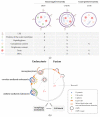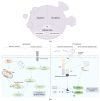Modulation of Autophagy and Cell Death by Bacterial Outer-Membrane Vesicles
- PMID: 37624259
- PMCID: PMC10467092
- DOI: 10.3390/toxins15080502
Modulation of Autophagy and Cell Death by Bacterial Outer-Membrane Vesicles
Abstract
Bacteria, akin to eukaryotic cells, possess the ability to release extracellular vesicles, lipidic nanostructures that serve diverse functions in host-pathogen interactions during infections. In particular, Gram-negative bacteria produce specific vesicles with a single lipidic layer called OMVs (Outer Membrane Vesicles). These vesicles exhibit remarkable capabilities, such as disseminating throughout the entire organism, transporting toxins, and being internalized by eukaryotic cells. Notably, the cytosolic detection of lipopolysaccharides (LPSs) present at their surface initiates an immune response characterized by non-canonical inflammasome activation, resulting in pyroptotic cell death and the release of pro-inflammatory cytokines. However, the influence of these vesicles extends beyond their well-established roles, as they also profoundly impact host cell viability by directly interfering with essential cellular machinery. This comprehensive review highlights the disruptive effects of these vesicles, particularly on autophagy and associated cell death, and explores their implications for pathogen virulence during infections, as well as their potential in shaping novel therapeutic approaches.
Keywords: OMV; apoptosis; autophagy; cell death; infection; inflammation; pyroptosis; xenophagy.
Conflict of interest statement
The authors declare no conflict of interest.
Figures



Similar articles
-
Bacterial outer membrane vesicles and host cell death signaling.Trends Microbiol. 2021 Dec;29(12):1106-1116. doi: 10.1016/j.tim.2021.04.003. Epub 2021 May 14. Trends Microbiol. 2021. PMID: 34001418 Review.
-
Metabolic Remodeling, Inflammasome Activation, and Pyroptosis in Macrophages Stimulated by Porphyromonas gingivalis and Its Outer Membrane Vesicles.Front Cell Infect Microbiol. 2017 Aug 4;7:351. doi: 10.3389/fcimb.2017.00351. eCollection 2017. Front Cell Infect Microbiol. 2017. PMID: 28824884 Free PMC article.
-
Beyond Inflammation: Role of Pyroptosis Pathway Activation by Gram-Negative Bacteria and Their Outer Membrane Vesicles (OMVs) in the Interaction with the Host Cell.Cells. 2024 Oct 23;13(21):1758. doi: 10.3390/cells13211758. Cells. 2024. PMID: 39513865 Free PMC article. Review.
-
Outer membrane vesicles from Pseudomonas aeruginosa induce autophagy-regulated pyroptosis in THP-1 cells.Arch Microbiol. 2025 Feb 10;207(3):54. doi: 10.1007/s00203-025-04264-9. Arch Microbiol. 2025. PMID: 39928143
-
Bacterial Outer Membrane Vesicle-Mediated Cytosolic Delivery of Flagellin Triggers Host NLRC4 Canonical Inflammasome Signaling.Front Immunol. 2020 Nov 18;11:581165. doi: 10.3389/fimmu.2020.581165. eCollection 2020. Front Immunol. 2020. PMID: 33312172 Free PMC article.
Cited by
-
Harnessing Bacterial Extracellular Vesicle Immune Effects for Cancer Therapy.Pathog Immun. 2024 Apr 23;9(1):56-90. doi: 10.20411/pai.v9i1.657. eCollection 2024. Pathog Immun. 2024. PMID: 38690563 Free PMC article. Review.
-
An Update on the Study of the Molecular Mechanisms Involved in Autophagy during Bacterial Pathogenesis.Biomedicines. 2024 Aug 5;12(8):1757. doi: 10.3390/biomedicines12081757. Biomedicines. 2024. PMID: 39200221 Free PMC article. Review.
-
Pathogenic mechanisms and potential applications of extracellular vesicles from periodontal pathogens in periodontitis.Front Immunol. 2024 Dec 20;15:1513983. doi: 10.3389/fimmu.2024.1513983. eCollection 2024. Front Immunol. 2024. PMID: 39759521 Free PMC article. Review.
-
Effects of Long-Acting Anticoagulant Rodenticides on Rabbit Plasma Extracellular Vesicles.ACS Omega. 2025 Apr 16;10(16):16410-16418. doi: 10.1021/acsomega.4c10887. eCollection 2025 Apr 29. ACS Omega. 2025. PMID: 40321562 Free PMC article.
-
First report on the physicochemical and proteomic characterization of Proteus mirabilis outer membrane vesicles under urine-mimicking growth conditions: comparative analysis with Escherichia coli.Front Microbiol. 2024 Nov 6;15:1493859. doi: 10.3389/fmicb.2024.1493859. eCollection 2024. Front Microbiol. 2024. PMID: 39568990 Free PMC article.
References
-
- Pérez-Cruz C., Carriòn O., Delgado L., Martinez G., Lòpez-Iglesias C., Mercade E. New Type of Outer Membrane Vesicle Produced by the Gram-Negative Bacterium Shewanella Vesiculosa M7T: Implications for DNA Content. Appl. Environ. Microbiol. 2013;79:1874–1881. doi: 10.1128/AEM.03657-12. - DOI - PMC - PubMed
Publication types
MeSH terms
LinkOut - more resources
Full Text Sources

